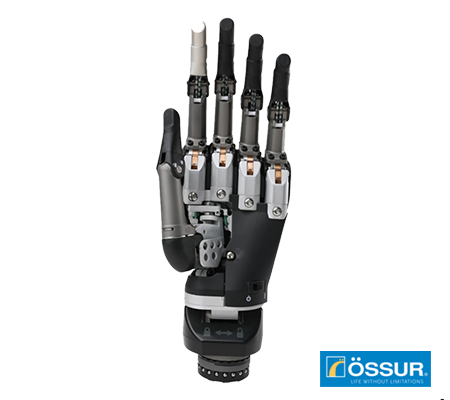The BIONIC* Hand
A replacement hand which resembles and acts like a real human hand, representing a generational advance in bionics and patient care.
The BIONIC Hand, is a prosthetic device with five independently motorized fingers and powered thumb rotation. The Hand was developed using leading-edge mechanical engineering techniques and is manufactured using titanium, and high-strength plastics. The result is a next-generation prosthetic device that is lightweight, robust and highly appealing to both patients and healthcare professionals.
The hand is controlled by a unique, highly intuitive control system that uses a traditional two-input myoelectric (muscle signal) to open and close the hand’s life-like fingers. Myoelectric controls utilize the electrical signal generated by the muscles in the remaining portion of the patient’s limb. This signal is picked up by electrodes that sit on the surface of the skin. Existing users of basic myoelectric prosthetic hands are able to quickly adapt to the system and can master the device’s new functionality within minutes.
Advanced Design
The modular construction employs Gesture control, enabling the automated grip to be accessed by moving the i-Limb® Quantum in one of four directions. For new patients, the hand offers a prosthetic solution that has never before been available.


Artificial Limbs
Prosthetic Legs or Arms; Prostheses can help people with leg and/or arm amputations get around more easily. Prosthetic Devices mimic the function and, sometimes, even the appearance of a real body parts. Some people may require a cane, walker, or crutches to increase stability while walking, while others can walk, and even run without encumbrance.
Prosthetic Technology Is Evolving
There are constant developments in prosthetic limb technology, such as microprocessor-driven and activity-specific components.
- Microprocessor joints feature computer chips and sensors to provide a more natural gait. They may even have different modes for walking on flat surfaces or up and down the stairs.
- There are also specialized prosthetic legs for different activities, such as running, showering or swimming, which you can switch to as needed. In some cases, your everyday prosthetic leg can be modified by your prosthetist to serve different purposes.
- Osseointegration surgery is another option. This procedure involves the insertion of a metal implant directly into the bone, so there is no need for a socket. The prosthetic leg then attaches directly to that implant. While this procedure is not right for everyone and is still under study, it can provide improved range of motion and sensory perception.
It’s important to remember that you’re not alone in navigating the many different prosthetic leg options. Your care team will help you weigh the pros and cons of each and decide on the ideal prosthetic leg that matches your lifestyle.
Design, structure, and fitting an orthosis can be a complex process.
3 Steps to Create an Orthosis
-
1
Assessment
Medical, physical, bio-mechanical, muscle strength, proprioception, and sensation
-
2
Design & Manufacturing
materials, construction, suspension, and cosmesis
-
3
Fitting and Evaluation
anatomical fit, function, easy to don/doff, comfortable to wear